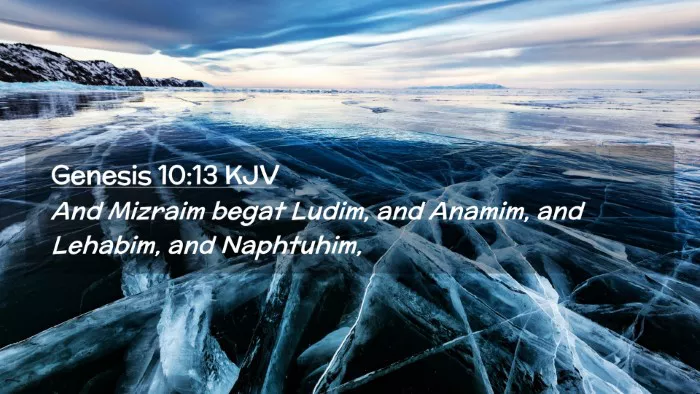Read the Daily Bible Verse Genesis 10:13 To Strengthen Your Spiritual Journey.
Genesis 10:13 KJV Background
And Mizraim begat Ludim, and Anamim, and Lehabim, and Naphtuhim.(Genesis 10:13, KJV)
Genesis 10:13 is part of the genealogical account in the Table of Nations, which traces the descendants of Noah‘s sons after the flood. Mizraim, often associated with Egypt, is mentioned here as the father of several groups, indicating the early dispersion of nations and peoples across different regions. This verse highlights the post-flood proliferation of humanity and sets the stage for understanding the ancient origins of various peoples.
Meaning of Genesis 10:13
The verse succinctly lists the descendants of Mizraim, representing the ancient Egyptian lineage. Each name in the verse corresponds to a distinct ethnic or tribal group that emerged in the regions associated with Mizraim. The names Ludim, Anamim, Lehabim, and Naphtuhim refer to different tribes or nations that were significant in the historical and cultural landscape of the ancient Near East.
Mizraim, a name commonly associated with Egypt, signifies the broader scope of Egyptian influence and its role in the ancient world. The naming of these groups underscores the process of migration and settlement that occurred in the wake of the flood, reflecting the early stages of human civilization’s expansion.
See also: Genesis 10:12 Meaning, Context & Commentary
Application of Genesis 10:13 in Life
Understanding Genesis 10:13 offers insight into the origins of various people groups and their historical significance. It reminds us of the interconnectedness of humanity and the diverse cultural heritage that has shaped our world. This genealogical account emphasizes the importance of history in understanding our present and appreciating the richness of different cultures.
For modern readers, this verse can inspire a sense of unity and respect for cultural diversity. By acknowledging the ancient roots of different peoples, we can foster a greater appreciation for the global tapestry of human history and the ways in which our ancestors have contributed to the world we live in today.
Comparison with Other Biblical Texts
Genesis 10:13 fits within the broader context of genealogical lists found in the Bible, such as those in 1 Chronicles 1 and the New Testament genealogies in Matthew 1 and Luke 3. These genealogical records serve to establish connections between different biblical figures and demonstrate the fulfillment of divine promises.
The Table of Nations in Genesis 10 contrasts with other genealogies by focusing on the dispersion of nations rather than specific individuals or covenants. While the genealogies in Matthew and Luke emphasize the lineage of Jesus Christ, Genesis 10:13 highlights the early distribution of peoples and their historical development.
Modern Relevance
In contemporary times, Genesis 10:13 offers a lens through which we can view the historical development of civilizations. It underscores the long-standing connections between different cultures and the significance of understanding our collective past. This perspective can enhance cross-cultural dialogue and promote a deeper appreciation of the historical roots that connect various peoples.
Additionally, this verse can be relevant in discussions about the origins of modern nations and the historical migration patterns that have shaped current geopolitical landscapes. By exploring the ancient genealogies, we gain valuable insights into the development of societies and their interactions over millennia.
Conclusion
Genesis 10:13 provides a glimpse into the early dispersal of nations and the origins of various peoples in the ancient world. Its genealogical record serves as a historical marker, emphasizing the diversity and interconnectedness of humanity. For modern readers, this verse invites reflection on the historical and cultural developments that have shaped our world, fostering a greater appreciation for the rich tapestry of human civilization.
Comments on Genesis 10:13
Historical Context: The verse situates Mizraim’s descendants in the broader narrative of post-flood humanity, illustrating the early spread of peoples and their cultural development.
Cultural Significance: The mention of these specific tribes underscores the importance of understanding the cultural and ethnic origins of ancient civilizations.
Genealogical Patterns: This verse contributes to the genealogical patterns observed throughout the Bible, linking historical narratives with broader themes of human dispersion and settlement.
Modern Insights: By examining ancient genealogies like Genesis 10:13, we can gain insights into the historical movements and interactions of different peoples, enhancing our understanding of contemporary cultural and geopolitical dynamics.

